Pyrimidin-2,4,6-triamin
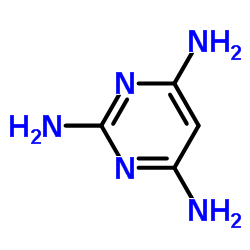
Pyrimidin-2,4,6-triamin structure
|
Common Name | Pyrimidin-2,4,6-triamin | ||
|---|---|---|---|---|
| CAS Number | 1004-38-2 | Molecular Weight | 125.132 | |
| Density | 1.5±0.1 g/cm3 | Boiling Point | 530.8±53.0 °C at 760 mmHg | |
| Molecular Formula | C4H7N5 | Melting Point | 249-251 °C(lit.) | |
| MSDS | Chinese USA | Flash Point | 308.2±18.1 °C | |
| Symbol |

GHS07 |
Signal Word | Warning | |
| Name | 2,4,6-triaminopyrimidine |
|---|---|
| Synonym | More Synonyms |
| Density | 1.5±0.1 g/cm3 |
|---|---|
| Boiling Point | 530.8±53.0 °C at 760 mmHg |
| Melting Point | 249-251 °C(lit.) |
| Molecular Formula | C4H7N5 |
| Molecular Weight | 125.132 |
| Flash Point | 308.2±18.1 °C |
| Exact Mass | 125.070145 |
| PSA | 103.84000 |
| LogP | -1.01 |
| Vapour Pressure | 0.0±1.4 mmHg at 25°C |
| Index of Refraction | 1.793 |
| Water Solubility | 36.5 g/L (20 ºC) |
Synonym: Section 2 - COMPOSITION, INFORMATION ON INGREDIENTS
Risk Phrases: 36/37/38 Section 3 - HAZARDS IDENTIFICATION EMERGENCY OVERVIEW
Irritating to eyes, respiratory system and skin.The toxicological properties of this material have not been fully investigated. Potential Health Effects Eye: Causes eye irritation. Skin: Causes skin irritation. Ingestion: May cause irritation of the digestive tract. The toxicological properties of this substance have not been fully investigated. Inhalation: Causes respiratory tract irritation. Chronic: Not available. Section 4 - FIRST AID MEASURES Eyes: Flush eyes with plenty of water for at least 15 minutes, occasionally lifting the upper and lower eyelids. Get medical aid. Skin: Flush skin with plenty of water for at least 15 minutes while removing contaminated clothing and shoes. Get medical aid if irritation develops or persists. Ingestion: If victim is conscious and alert, give 2-4 cupfuls of milk or water. Get medical aid. Inhalation: Remove from exposure and move to fresh air immediately. Get medical aid if cough or other symptoms appear. Notes to Physician: Section 5 - FIRE FIGHTING MEASURES General Information: As in any fire, wear a self-contained breathing apparatus in pressure-demand, MSHA/NIOSH (approved or equivalent), and full protective gear. Extinguishing Media: Use water spray, dry chemical, carbon dioxide, or chemical foam. Section 6 - ACCIDENTAL RELEASE MEASURES General Information: Use proper personal protective equipment as indicated in Section 8. Spills/Leaks: Vacuum or sweep up material and place into a suitable disposal container. Section 7 - HANDLING and STORAGE Handling: Avoid breathing dust, vapor, mist, or gas. Avoid contact with skin and eyes. Storage: Store in a cool, dry place. Store in a tightly closed container. Section 8 - EXPOSURE CONTROLS, PERSONAL PROTECTION Engineering Controls: Facilities storing or utilizing this material should be equipped with an eyewash facility and a safety shower. Exposure Limits CAS# 1004-38-2: Personal Protective Equipment Eyes: Wear chemical splash goggles. Skin: Wear appropriate protective gloves to prevent skin exposure. Clothing: Wear a chemical apron. Respirators: A NIOSH/MSHA approved air purifying dust or mist respirator or European Standard EN 149. Section 9 - PHYSICAL AND CHEMICAL PROPERTIES Physical State: Solid Color: slightly beige Odor: Not available. pH: Not available. Vapor Pressure: Not available. Viscosity: Not available. Boiling Point: Not available. Freezing/Melting Point: 249 - 251 deg C Autoignition Temperature: Not available. Flash Point: Not available. Explosion Limits, lower: Not available. Explosion Limits, upper: Not available. Decomposition Temperature: Solubility in water: slightly soluble Specific Gravity/Density: Molecular Formula: C4H7N5 Molecular Weight: 125.13 Section 10 - STABILITY AND REACTIVITY Chemical Stability: Stable under normal temperatures and pressures. Conditions to Avoid: Not available. Incompatibilities with Other Materials: Strong oxidizing agents. Hazardous Decomposition Products: Carbon monoxide, oxides of nitrogen, carbon dioxide. Hazardous Polymerization: Will not occur. Section 11 - TOXICOLOGICAL INFORMATION RTECS#: CAS# 1004-38-2 unlisted. LD50/LC50: Not available. Carcinogenicity: 2,4,6-Triaminopyrimidine, 97% - Not listed by ACGIH, IARC, or NTP. Section 12 - ECOLOGICAL INFORMATION Section 13 - DISPOSAL CONSIDERATIONS Dispose of in a manner consistent with federal, state, and local regulations. Section 14 - TRANSPORT INFORMATION IATA Not regulated as a hazardous material. IMO Not regulated as a hazardous material. RID/ADR Not regulated as a hazardous material. Section 15 - REGULATORY INFORMATION European/International Regulations European Labeling in Accordance with EC Directives Hazard Symbols: XI Risk Phrases: R 36/37/38 Irritating to eyes, respiratory system and skin. Safety Phrases: S 26 In case of contact with eyes, rinse immediately with plenty of water and seek medical advice. S 37/39 Wear suitable gloves and eye/face protection. WGK (Water Danger/Protection) CAS# 1004-38-2: No information available. Canada CAS# 1004-38-2 is listed on Canada's DSL List. CAS# 1004-38-2 is not listed on Canada's Ingredient Disclosure List. US FEDERAL TSCA CAS# 1004-38-2 is listed on the TSCA inventory. SECTION 16 - ADDITIONAL INFORMATION N/A |
| Symbol |

GHS07 |
|---|---|
| Signal Word | Warning |
| Hazard Statements | H315-H319-H335 |
| Precautionary Statements | P261-P305 + P351 + P338 |
| Personal Protective Equipment | dust mask type N95 (US);Eyeshields;Gloves |
| Hazard Codes | Xi:Irritant |
| Risk Phrases | R36/37/38 |
| Safety Phrases | S26-S36-S37/39 |
| RIDADR | NONH for all modes of transport |
| WGK Germany | 3 |
| HS Code | 2933599090 |
|
~% 
Pyrimidin-2,4,6... CAS#:1004-38-2 |
| Literature: Journal of the American Chemical Society, , vol. 72, p. 4271 Journal of the American Chemical Society, , vol. 73, p. 3862 |
|
~86% 
Pyrimidin-2,4,6... CAS#:1004-38-2 |
| Literature: Bioorganic and Medicinal Chemistry Letters, , vol. 15, # 1 p. 73 - 76 |
|
~% 
Pyrimidin-2,4,6... CAS#:1004-38-2 |
| Literature: Chemische Berichte, , vol. 37, p. 4547 |
|
~% 
Pyrimidin-2,4,6... CAS#:1004-38-2 |
| Literature: Chemische Berichte, , vol. 34, p. 3363 |
|
~% 
Pyrimidin-2,4,6... CAS#:1004-38-2 |
| Literature: Chemische Berichte, , vol. 36, p. 2234 Chemische Berichte, , vol. 34, p. 3363 |
|
~% 
Pyrimidin-2,4,6... CAS#:1004-38-2 |
| Literature: Journal of the American Chemical Society, , vol. 135, # 7 p. 2447 - 2450 |
|
~% 
Pyrimidin-2,4,6... CAS#:1004-38-2 |
| Literature: Chemische Berichte, , vol. 36, p. 2227 Chemische Berichte, , vol. 34, p. 3363 |
|
~82% 
Pyrimidin-2,4,6... CAS#:1004-38-2 |
| Literature: Australian Journal of Chemistry, , vol. 60, # 2 p. 120 - 123 |
|
~% 
Pyrimidin-2,4,6... CAS#:1004-38-2 |
| Literature: Journal of Heterocyclic Chemistry, , vol. 25, # 6 p. 1697 - 1700 |
| Precursor 8 | |
|---|---|
| DownStream 10 | |
| HS Code | 2933599090 |
|---|---|
| Summary | 2933599090. other compounds containing a pyrimidine ring (whether or not hydrogenated) or piperazine ring in the structure. VAT:17.0%. Tax rebate rate:13.0%. . MFN tariff:6.5%. General tariff:20.0% |
|
Determination of the driving force for the sodium pump (ENa) and of active and passive conductances (GNa and Gsh) in isolated toad skin: influence of antidiuretic hormone.
Gen. Pharmacol. 18(6) , 589-92, (1987) 1. Values of the sodium potential (ENa), active conductance (GNa) and passive conductance (Gsh) were measured in the isolated skin of the toad Pleurodema thaul placed in an Ussing chamber, and Isaacso... |
|
|
Mechanism of ammonium transport by intestinal segments following urinary diversion: evidence for ionized NH4+ transport via K(+)-pathways.
J. Urol. 148(2 Pt 1) , 453-7, (1992) Using a previously reported in vivo intestinal perfusion model in the rat, we have shown that net total ammonium absorption accounts for the majority of the acid load resulting from urinary intestinal... |
|
|
Factors affecting the potassium concentration at the mucosal surface of the proximal and the distal colon of guinea pig.
Gut 31(1) , 64-9, (1990) K+ concentrations were measured in vitro with K+ sensitive microelectrodes in the microclimate at the luminal cell surface of the colon of guinea pigs. The serosal K+ concentration was mostly 5.4 mmol... |
| TRIAMINOPYRIMIDINE |
| EINECS 213-720-7 |
| 1,3,5-triaminopyrimidine |
| Pyrimidine-2,4,6-triamine |
| 2,3-DIHYDRO-BENZOFURAN-3-YLAMINE HYDROCHLORIDE |
| 6-TriaMinopyriMidine |
| 2,4,6-Pyrimidinetriamine |
| MFCD00006100 |
| 2,4,6-triamino pyrimidine |
| 2,4,6-Triaminopyrimidin |
| 2,4,6-Triaminopyrimidene |
| IFLAB-BB F1918-0050 |
| Pyrimidin-2,4,6-triamin |
| 2,4,6-Traminopyrimidne |
| 2,4,6-Triamino |
| 2,4,6-Triaminopyrimidine |
| 2,4,6-Triamino Pyridine |
| 2,4,6-TRIAMINO-PYRIMIDINE |





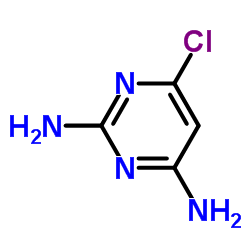


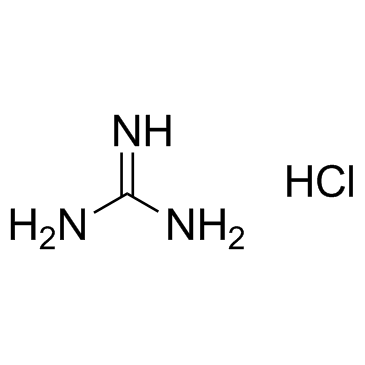

![1H-Pyrrolo[2,3-d]pyrimidine-2,4-diamine (9CI) structure](https://image.chemsrc.com/caspic/171/18620-92-3.png) CAS#:18620-92-3
CAS#:18620-92-3![5,7-Diamino-1H-1,2,3-triazolo[4,5-d]pyrimidine structure](https://image.chemsrc.com/caspic/481/18620-97-8.png) CAS#:18620-97-8
CAS#:18620-97-8 CAS#:2227-25-0
CAS#:2227-25-0![7,8,9,10-tetrahydropyrimido[4,5-c]isoquinoline-1,3-diamine structure](https://image.chemsrc.com/caspic/164/19181-36-3.png) CAS#:19181-36-3
CAS#:19181-36-3![Benzenesulfonic acid,4-[2-(2,4,6-triamino-5-pyrimidinyl)diazenyl]- structure](https://image.chemsrc.com/caspic/065/2877-65-8.png) CAS#:2877-65-8
CAS#:2877-65-8 CAS#:31458-45-4
CAS#:31458-45-4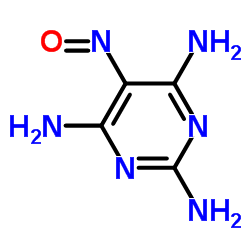 CAS#:1006-23-1
CAS#:1006-23-1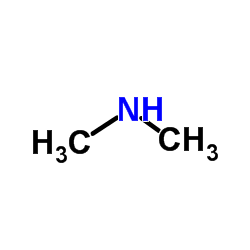 CAS#:124-40-3
CAS#:124-40-3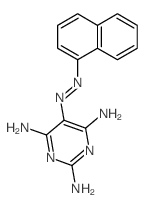 CAS#:32524-43-9
CAS#:32524-43-9
